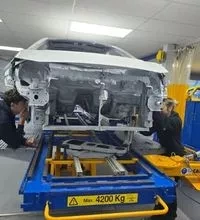Five ways to support your apprentice

In this article: Apprenticeships are a fantastic opportunity for both those learning a new skills and companies taking them on, here’s five tips to help your staff get the most from their apprenticeship.
Making your apprentice feel welcome and supported is crucial in getting the most out of them and reaping the incredible return on investment from an apprenticeship. The IMI’s figures show that a level 3 automotive maintenance and repair apprentice can yield a ROI of more than 200% in three years.
Sabina Hegarty, Managing Director of Calibre Group Solutions, a training provider to the motor industry gives her five tips to help your staff through their apprenticeship.
1. Good intentions
The first step is having the right intentions for taking on an apprentice in the first place. These include upskilling a workforce so as to future-proof it, and taking on apprentices for the long haul.
Yet unfortunately, Hegarty says, many employers are recruiting apprentices simply to claw back money they have paid into the apprenticeship levy, a payroll tax on large employers, and bin them once the training ends.
“The levy was designed to bring on the next generation, to give people the opportunity to learn a trade, not to produce cheap labour and reduce unemployment figures,” she says, with feeling. “It doesn’t bode well for employers, as they won’t get the talent the motor industry really needs.”
2. The perfect fit
When recruiting an apprentice, the manager who will be responsible for them must be involved in the selection process, adds Hegarty.
This will ensure a good fit with the apprentice’s personality and the organisational culture, which differs, she says. “The Bentley showroom, for example, is quiet, serene and calm. If you have a gung-go BMW salesman giving it large with lots of banter, they would not fit in.”
She recommends a personality test to match working styles, which is known as “business chemistry”.
3. The buddy system
The third step is putting in place the right framework to support the apprentices once they join the organisation. This includes a dedicated apprenticeship manager who can guide them through their programme, and answer any questions they have.
Hegarty says: “It’s important that the apprentice has a direct line manager responsible for their education, training and wellbeing.
“The apprentice will be a headless chicken without direction. That’s a waste of an apprenticeship – they simply won’t progress, will be unmotivated and may leave the organisation.”
She also recommends a “buddy”: an experienced employee at the organisation that the apprentice can ask simple questions of, like what time lunch is. “They might fear pestering the line manager with rudimentary stuff.”
4. Onboarding
In addition, put an onboarding process in place to ensure the apprentice feels welcome and can hit the ground running, especially if they are young with little experience of work.
“You have to believe in the apprentices and make them feel valued from day one. They need an induction, somewhere to sit, should meet the team, managers and know where to go for help or advice,” says Hegarty.
“If you get this right, the apprentice will think, ‘this is the employer for me for the future’.”
5. The theory test
Her final tip is a study schedule that minimises disruption to the apprentice’s job. Some employers set aside time in the morning before the workplace gets busy. The key is to experiment and find a timetable works for everyone.
“Apprentices must spend a minimum of 20% of their time training off-the-job, under government rules that are a big bugbear for employers, as they have to pay them a full salary,” says Hegarty.
“Apprentices can only do the practical part if they understand the theory. Would you let them drive a car if they had not passed their theory test?”




